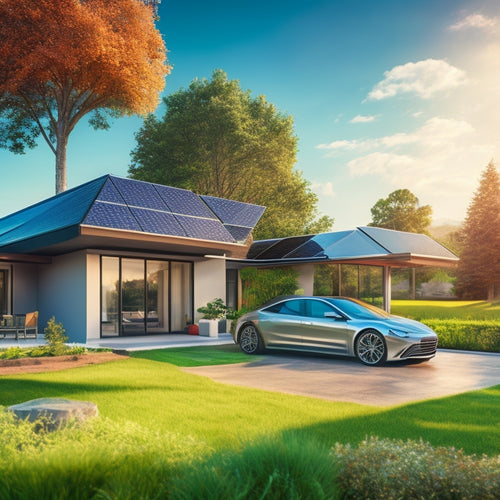
Essential Components of a Home Solar Panel and Battery System
Share
When designing a home solar panel and battery system, you need to take into account a combination of critical components that work together seamlessly to guarantee maximum energy independence, efficiency, and cost savings. You'll need to optimize your solar panel array configuration, select the right inverter technology, and choose a suitable battery type and energy storage capacity. A charge controller, monitoring and tracking system, mounting and racking system, and power conversion and safety features are also essential. With these components in place, you'll be able to generate, store, and apply clean energy efficiently. Now, explore deeper into each of these components to reveal the full potential of your system.
Key Takeaways
- A solar panel array configuration must be optimized for maximum energy production, considering orientation, tilt angle, and shading analysis.
- Inverter technology and efficiency play a crucial role in converting DC power to AC power, with high-efficiency inverters minimizing energy losses.
- Battery type and energy storage capacity must be selected based on energy needs and usage patterns, with larger capacity allowing for more excess energy storage.
- A charge controller regulates energy flow between solar panels and the battery bank, preventing overcharging and undercharging, and prolonging battery lifespan.
- Monitoring and tracking systems provide real-time observations of energy consumption and production, enabling data-driven decisions for system optimization.
Solar Panel Array Configuration
When designing a home solar panel and battery system, configuring the solar panel array is a vital step. You'll want to guarantee the array is optimized for maximum energy production, considering factors like solar orientation and shading analysis.
Solar orientation refers to the direction and tilt of your solar panels, which greatly impacts energy output. Ideally, your panels should face south (in the northern hemisphere) and be tilted at an angle between 30-40 degrees to maximize energy production.
Conducting a shading analysis is also important to identify potential obstructions, such as trees or buildings, that could reduce energy output. This analysis helps you determine the best location and configuration for your array.
Inverter Technology and Function
You're now considering the critical component that converts DC power from your solar panels into AC power for your home: the inverter.
You'll want to understand the different types of inverters available, such as string inverters, microinverters, and power optimizers, each with their own strengths and weaknesses.
The efficiency of your inverter will greatly impact the overall performance of your solar panel and battery system, so it's vital to choose the right one.
Types of Inverters
How efficiently can your home solar panel and battery system convert DC power into usable AC electricity? This depends on the type of inverter you choose.
String inverters are the most common type, connecting multiple solar panels in a series. Microinverters, on the other hand, are attached to each individual panel, providing more flexibility and monitoring capabilities. Power optimizers offer a compromise between the two, optimizing energy production at the panel level.
Hybrid inverters combine solar and battery management into one unit, making them ideal for off-grid systems. Off-grid inverters, as the name suggests, are designed for systems not connected to the grid. Grid-tied inverters, in contrast, synchronize with the grid's frequency and voltage.
When selecting an inverter, consider factors such as inverter lifespan, maintenance requirements, and sizing. Be certain to review the inverter specifications to guarantee compatibility with your system's unique needs.
Inverter Efficiency Matters
Your inverter's efficiency plays a significant role in determining the overall performance of your home solar panel and battery system. A highly efficient inverter guarantees that you're getting the most out of your solar panels and storing excess energy in your battery for later use.
When selecting an inverter, look for one with a high efficiency rating, typically above 95%. This will minimize energy losses and maximize your system's overall performance.
Here are some key considerations to keep in mind:
-
Inverter lifespan: A high-efficiency inverter can last longer, reducing the need for frequent replacements and minimizing maintenance costs.
-
Inverter maintenance: Regular maintenance is essential to guarantee your inverter operates at peak efficiency. This includes cleaning the unit, checking for firmware updates, and monitoring performance metrics.
-
Optimal system design: A well-designed system that takes into account your energy needs, solar panel output, and inverter efficiency can help you achieve maximum energy independence and cost savings.
Mounting and Racking Systems
You'll need to decide on a mounting and racking system to secure your solar panels and guarantee maximum energy production.
Roof mounting options, such as flush mounts, rail-based systems, and solar shingles, offer a sleek and efficient way to integrate solar panels into your home's design.
Alternatively, ground mounting systems provide flexibility and ease of installation, making them a popular choice for larger solar arrays.
Roof Mounting Options
Installing a home solar panel system requires a sturdy and reliable mounting system to secure the panels to your roof. As you consider roof mounting options, you'll want to think about the unique characteristics of your roof and how they'll impact your system's performance.
When selecting a roof mounting system, consider the following key factors:
-
Roof orientation and installation height: Make certain your mounting system is designed to accommodate your roof's orientation and the height at which you'll be installing your panels. This will help optimize energy production and reduce shading.
-
Aesthetic considerations and load distribution: Choose a mounting system that not only looks good but also distributes the weight of your panels evenly, reducing the risk of damage to your roof.
-
Weather resistance and maintenance access: Opt for a system that can withstand harsh weather conditions and provides easy access for maintenance and repairs, reducing the need for costly and time-consuming repairs down the line.
Ground Mounting Systems
Ground Mounting Systems (Mounting and Racking Systems)
You're considering a ground mounting system for your solar panel installation, which offers more flexibility regarding panel orientation and tilt. This type of system is ideal for homes with ample space, as it doesn't require a roof installation.
When selecting a site for your ground mounting system, verify the area receives sufficient sunlight and has good ground stability. Follow installation guidelines to guarantee a secure and efficient setup.
Cost considerations will vary depending on the size of your system and local regulations. Keep in mind that ground mounting systems often require more materials and labor than roof-mounted systems, increasing upfront costs.
However, they also offer more aesthetic options, such as adjustable tilt and seasonal tracking, which can enhance energy output. Additionally, these systems require less maintenance, as they're more accessible and easier to clean.
Look for durability features, such as corrosion-resistant materials and weather-tight connections, to verify your system lasts for years to come.
Battery Type and Chemistry
In tandem with the solar panel array, the battery type and chemistry play an essential role in determining the overall performance and efficiency of your home solar panel and battery system.
As you consider your battery options, you'll encounter various types, each with its strengths and weaknesses.
You'll likely come across lithium-ion batteries, known for their high energy density and long cycle life. Lead acid batteries, on the other hand, offer a more affordable option with a well-established manufacturing infrastructure.
Flow batteries, a less common type, provide a scalable solution with a long lifespan.
When evaluating battery types, consider the following key factors:
- Battery management: Confirm the system includes a strong battery management system to prevent overcharging, overheating, and deep discharging.
- Thermal stability: Assess the battery's thermal stability to guarantee safe operation across various temperatures.
- Charging speed: Consider the charging speed, as faster charging times can increase the system's overall efficiency.
Charge Controller Functions
Your home solar panel and battery system relies on a charge controller to regulate the flow of energy between the solar panel array and the battery bank. This essential component guarantees efficient energy transfer, preventing overcharging or undercharging of your batteries.
The charge controller's primary function is charge regulation, which assures battery compatibility and prolongs its lifespan. Additionally, it manages load distribution, optimizing system performance and energy efficiency.
During installation, it's important to take into account the charge controller's capacity to handle the solar panel array's maximum power output. Proper installation and maintenance practices are crucial to guarantee the system operates within safety standards.
Monitoring the charge controller's performance helps identify potential issues, allowing for swift intervention and minimizing downtime. When selecting a charge controller, evaluate cost considerations, such as the initial investment and long-term maintenance costs.
Monitoring and Tracking Systems
As you optimize your home solar panel and battery system, a monitoring and tracking system becomes essential to guarantee peak performance and identify potential issues. This system provides you with real-time observations into your energy consumption and production, enabling you to make data-driven decisions to optimize your system's performance.
With a monitoring and tracking system, you'll have access to:
-
Performance analytics and historical data to identify trends and areas for improvement
-
A user-friendly interface with mobile access for convenient monitoring and control
-
Energy forecasting and system alerts to notify you of potential issues or performance deviations, allowing for remote management and prompt resolution
Energy Storage Capacity
You're likely wondering how much energy your home solar panel and battery system can store, and that's where energy storage capacity comes in. This component determines the amount of electricity your system can hold, measured in kilowatt-hours (kWh). A higher energy storage capacity means you can store more excess energy generated by your solar panels during the day for use during the night or on cloudy days.
When selecting a battery system, you'll want to take into account your energy needs and usage patterns. A larger battery capacity can provide more backup power during outages, but it also increases the overall cost of the system.
A key aspect of energy storage capacity is energy management, which involves optimizing the charging and discharging of your batteries to maximize their lifespan and efficiency. A well-designed energy management system guarantees that your batteries are charged when excess energy is available and discharged when you need it most.
Power Conversion and Safety
You're about to investigate the critical components that guarantee your home solar panel and battery system operates efficiently and safely.
The inverter plays an important role in converting DC power from your solar panels to AC power for your home, while also monitoring and controlling the flow of energy.
As you consider your power conversion and safety needs, it's important to understand how your system's design and components, such as safe energy storage solutions, work together to provide reliable and secure power.
Inverter Functionality Explained
Most modern home solar panel systems rely on an inverter to convert the DC power generated by the solar panels into AC power that's usable in your home. This vital component guarantees you can power your appliances, lights, and other devices with clean energy.
The inverter's functionality goes beyond simple power conversion, though. It also provides significant safety features, such as grounding fault protection and Arc Fault Circuit Interrupter (AFCI) protection. These features safeguard your system from electrical shocks, fires, and other hazards.
To keep your inverter running smoothly, it's important to:
-
Follow inverter maintenance tips, like regular cleaning and inspection, to prevent overheating and component failure.
-
Familiarize yourself with inverter troubleshooting techniques, such as monitoring performance data and error codes, to identify and address issues promptly.
-
Verify your inverter is installed, configured, and integrated correctly with your solar panel and battery system to optimize its performance and lifespan.
Safe Energy Storage
How do you guarantee that the energy generated by your solar panel system is stored safely and efficiently? The answer lies in a well-designed energy storage system that prioritizes battery safety and effective energy management.
A reliable battery management system (BMS) is vital in preventing overheating, overcharging, and deep discharging, which can greatly reduce the lifespan of your batteries. The BMS monitors and controls the state of charge, voltage, and temperature of each battery cell, ensuring that they operate within a safe and ideal range.
This advanced technology also provides real-time monitoring and alerts, enabling you to take prompt action in case of any anomalies. Additionally, a dedicated energy management system optimizes energy distribution, ensuring that your home receives a stable and efficient supply of power.
Grid Connection and Net Metering
With grid connection and net metering, your home solar panel and battery system seamlessly integrates with the existing electrical grid, allowing you to harness the power of renewable energy while still having access to the grid when needed.
This setup guarantees grid reliability, as you can draw energy from the grid during periods of low solar production or high energy demand.
Grid connection and net metering offer several benefits, including:
-
Energy credits: You can sell excess energy generated by your solar panel system back to the grid and receive energy credits, which can offset your energy bills during periods of low solar production.
-
Grid backup: In the event of a power outage, your solar panel and battery system can provide backup power, assuring your home remains energized and comfortable.
-
Peak shaving: By storing excess energy generated during the day and using it during peak hours, you can reduce your energy bills and minimize your reliance on the grid.
System Installation and Wiring
What considerations do you need to keep in mind when installing a home solar panel and battery system? One vital aspect is installation safety. You must guarantee that the installation team follows strict safety protocols to prevent electrical shock, falls, and other hazards. Additionally, wiring best practices are important to guarantee the system operates efficiently and safely. Proper wiring connections, cable management, and labeling are essential to prevent electrical fires and guarantee the system's reliability.
| Installation Safety Considerations | Wiring Best Practices |
|---|---|
| Guarantee a safe working environment | Use UL-listed cables and connectors |
| Wear personal protective equipment | Label all cables and components |
| Follow manufacturer guidelines | Keep cables organized and secure |
Frequently Asked Questions
Can I Install a Solar Panel System Myself to Save Money?
You can attempt a DIY installation to save on labor costs, but be aware that it may void warranties, compromise system efficiency, and even pose safety risks, outweighing potential cost savings.
How Long Does It Take to Pay off a Solar Panel System Investment?
As you plant the seeds of sustainability, you'll harvest a return on investment in 5-7 years, thanks to solar incentives that help your system bloom, bringing you long-term savings and a sense of eco-friendly satisfaction.
Do Solar Panels Work During Power Outages or at Night?
You'll be glad to know that solar panels don't produce energy during power outages or at night, but with solar energy storage, you can achieve grid independence, ensuring a steady supply of clean energy when you need it most.
Are Solar Panels Durable Enough to Withstand Harsh Weather Conditions?
You'll be relieved to know that modern solar panels are built to withstand harsh weather conditions; high-quality solar panel materials guarantee weather resistance, allowing them to perform at their best even in extreme temperatures, heavy rainfall, and strong winds.
Can I Expand My Solar Panel System in the Future if Needed?
You can easily expand your solar panel system in the future if needed, ensuring system compatibility and seamless future upgrades, as long as you choose a scalable design and high-quality components that can adapt to your growing energy demands.
Conclusion
As you stand ready to utilize the power of the sun, remember that each component of your home solar panel and battery system is an essential thread in the intricate fabric of renewable energy. Without a single, well-designed piece, the entire system would fall apart. With this thorough understanding, you're now enabled to weave together a seamless, efficient, and sustainable energy solution that illuminates your path to a greener future.
Related Posts
-

What Solar Panels Work Best With EVS Online?
When shopping for solar panels online to power your electric vehicle, look for high-efficiency models that can withst...
-

Eco-Friendly Car Battery Solutions Available Online
You can now shop online for eco-friendly car battery solutions that not only reduce your carbon footprint but also of...
-

Safely Staying on Course: 5 Essential Lane Tips
You're about to take your driving skills to the next level by mastering the art of staying in your lane. First, inves...


